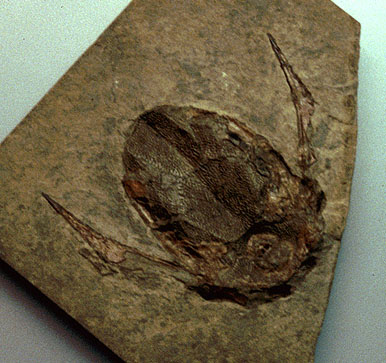- Bothriolepis
Taxobox
name = "Bothriolepis"
fossil_range = LateDevonian

image_width = 200px
regnum =Animal ia
phylum = Chordata
subphylum = Vertebrata
classis =Placodermi
ordo =Antiarchi
familia =Bothriolepidae
genus = "Bothriolepis"
genus_authority = Eichwald, 1840"Bothriolepis" ("pitted scale" or "trench scale") was the most successful
genus ofantiarch placoderm s, if not the most successful genus of any placoderm, with over 100 species found on every continent. It was a smallbenthic freshwaterdetrivore which lived in the Middle and LateDevonian (387–360 million years ago). Because the fossils are found in freshwater sediments, "Bothriolepis" is presumed to have spent most of its life infreshwater rivers and lakes, but was probably able to enter salt water as well because its range appeared to have corresponded with the Devonian continental coastlines. Many paleontologists hypothesize that they wereanadromous , that is, they actually lived in saltwater, and returned to freshwater to breed, similar tosalmon . Its box-like body was enclosed in armor plates, providing protection from predators.It had a heavily armoured head fused with the
thoracic shield. It had a long pair of spine-likepectoral fin s, joined at two points: one where the arm leaves the trunk and one a little more than half way along, which would have helped to lift it from the bottom; its heavy body would have sunk quickly back to the bottom as soon as forward momentum was lost. The fins possessed spines, and an articulation to the boxlike trunk. "Bothriolepis" had a peculiar spiral, sediment-filled gut and probably grubbed in the mud. It may also have used its pectoral fins to throw sediment (mud, sand or otherwise) over itself.There are two openings through its head: a keyhole opening along the midline on the upper side for the eyes and nostrils and a mouth on the lower side near the front. It also had a special feature on its skull, a separate partition of bone below the opening for the eyes and nostrils enclosing the nasal capsules called a
preorbital recess . It had gills in addition to a pair of pouches off theesophagus that, according to scientific speculation, may have functioned as lungs. "Bothriolepis" had a slender fish-like tail that extended behind the heavily armored portion, which is unfortunately rarely preserved in fossils.Gallery
External links
*
Mikko's Phylogeny Archive " [http://www.fmnh.helsinki.fi/users/haaramo/Metazoa/Deuterostoma/Chordata/Placodermi/Bothriolepis.htm Bothriolepis] "
Wikimedia Foundation. 2010.
